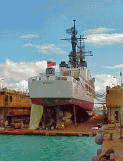Hydrostatics for One Waterline (English
Units)
Description:
This spreadsheet
automatically computes hydrostatics characteristics for
one waterline. If the waterline is level this data may be used as an
input source for the vessel's "Curves of Form." If
the waterline is not level (and/or includes sag or hog) this template can
also be used. It is ideal for cases where the vessel exceeds the one
percent allowable trim at a stability test (inclining experiment).
This spreadsheet combines the three Hawaii Marine
Templates into one. These are the Displacement Sheet (Product
Disp-e), the Waterplane Sheet (Product
WP-e) and the
Waterline Input/Output Sheet (Product
WL-IO-e). This combination facilitates faster and easier
computation for a given waterline. These combined case calculations
are more automated, significantly minimizing entry input time.
Electronic
Document Type: Microsoft Excel
spreadsheet Cost:
$15.00 US funds
Number of
Pages: single
sheet
Inputs:
Outputs:
The
automatic output generated are: from Sheet 2 -displaced
volume (V), displacement (W), longitudinal center of
buoyancy (LCB), vertical center of buoyancy (VCB), from Sheet
3 - waterplane area (AWP), longitudinal center of floatation
(LCF), longitudinal moment of inertia about the LCF (ILCF),
transverse moment of inertia (IT), and from Sheet 1 - tons per Inch (TPI),
longitudinal metacentric radius (BML), transverse metacentric
radius (BMT), distance from keel to longitudinal metacenter (KML),
distance from keel to transverse metacenter (KMT), bock
coefficient (CB), prismatic coefficient (CP), and miship's
coefficient (CM).
Suggested
Reading (see
References page for
more detail on these items):
Microsoft Excel user manuals
Principles of Naval Architecture, Edward V. Lewis, SNAME
Basic Ship Theory, Rawson & Tupper
Applied Naval Architecture, Robert B. Zubaly
Introduction to Naval Architecture, E. C. Tupper
Introduction to Naval Architecture, Thomas Gillmer and
Bruce Johnson
Terms:
Prior to purchase, read our
End
User License Terms.
Important Notice to European Union Buyers:
Due to changes in international law, we no longer accept
purchases from any individuals located within an EU country.
However, businesses located within the EU are allowed to make
purchases, provided that they make the VAT payments for any imported
items purchased electronically. These EU businesses must
specify their VAT number in the memo section on the Paypal
payment pages. These changes are effective as of July 1, 2008,
and were modified for EU businesses on April 9, 2010.
Download
Now:
Click one of the following buttons to pay.
After payment you will be taken directly to the download page.
Minimum
System Requirements: Windows 95/98/NT/2000/XP/Vista/Windows7
Sample:
A sample document is shown below.

|



